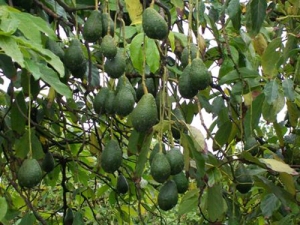My Avocado Footprint
/
By Denise Balkissoon
I was into avocados before they were cool.
I have loved their creamy, subtle flesh since I learned to pick the fruit from the tree in my aunt’s backyard in San Fernando. The Trinidadian world for avocado is “zaboca,” and I was well known to be a zaboca freak—obliging aunties coming to Canada would smuggle newspaper-wrapped booty in their giant suitcases. When guacamole came onto the food scene during my teen years, I adopted a tired, worldly attitude, informing everyone that “avocados” were nothing new. In reality, the appearance of $1 zabocas was a cause for celebration: I no longer had to convince my parents to stop by Nicey’s and shell out.
The little pear isn’t an exotic ingredient anymore. Since I was born with a guilty conscience, it weighs on me that my favourite food is now easy pickings. Zabocas have evolved from an occasional treat to an everyday food, one that’s in cheap sushi and expensive sandwiches, and one that’s impossible to grow within 100 (or 1,000) miles from my house. Each bite is a carbon sin. I used to be a second-gen kid longing for a taste of my childhood. Now, I’m just North American scum.
The lines connecting “ethnic” to “green” food are twisty. There are butchers trying to educate kosher eaters about avoiding factory farms, and there is halal vanilla made with propylene glycol, a known carcinogen. I once knew a born-and-raised Jain who had never eaten animal flesh, and had no urge to: he very regularly had cravings for his version of a Big Mac, which was basically bread, pickles and special sauce (McD’s charged him full price). The year-old FoodShare market at Jane and Finch sells bok choy and mangos as well as local blueberries. Oyster mushrooms look cool, but the reason Ontario farmers grow them is because they sell. Local is lovely and we’d all eat more organic if we could afford it, but catering to real appetites is the bottom line. Recently, I had a bang-up avant-Asian meal at Rocky Raccoon in Owen Sound, where a Nepalese chef using Grey County ingredients offered house-made naan topped with local butter, maple syrup and subcontinental spices. That meal help convinced me that giving up familiar tastes doesn’t always mean a loss. Sometimes, like in a yellow dahl soup made earthy and intensely oniony with wild leeks, it means a real, delicious gain.
I ate vegetarian for three years, and once asked my mother to find and buy me a chayote. I had no idea what it would taste like, but the fancy vegetarian cookbook I was reading told me I should be stuffing one. She came back from the store with three chayotes, and informed me that they cost $7. “When I was vegetarian, it was because I was poor,” opined my father, who grew up on a farm, walked to school without shoes, only ate meat at weddings, etc. I’ve noticed that lots of immigrants, regardless of birthplace, consider eating copious amounts of animal one sign that they’ve achieved the Canadian Dream. A cousin once made me a quick dish of curried potatoes when a family potluck turned out not to have one meat-free offering. One of my uncles couldn’t stop shoveling it back. “I’ve always loved aloo,” he said between mouthfuls, as if someone had been preventing him from eating it. In the rush to prove that he could eat meat, he had forgotten to consider whether he wanted to.
My zaboca consumption has stayed steady through recent price increases. I can’t imagine the dollar value that would make me swear off for good (though bananas are apparently now $9 a pound in Australia–global food definitely has a tipping point). I promise, though, that I’ll pause before my next purchase, and think about whether, just this one time, I can nourish myself another way.








